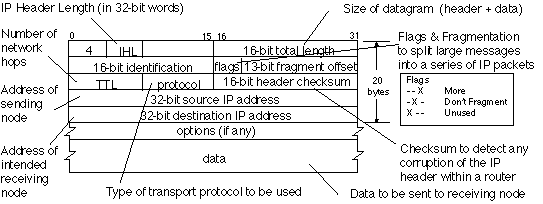IPv4 Packet Header
from:
The uses a service to transfer
packets of data between using .
The
IPv4 packet header consists of 20 bytes of data. An option exists
within the header that allows further optional bytes to be added, but
this is not normally used (with the occasional exception of something
called "Router Alert"). The full header is shown below:
The header fields are discussed below:
- Version (always set to the value 4 in the current version of IP)
- IP Header Length (number of 32 -bit words forming
the header, usually five)
- , now known as (usually
set to 0, but may indicate particular Quality of Service needs from the
network, the DSCP defines the way routers should queue packets while
they are waiting to be forwarded).
- Size of Datagram (in bytes, this is the combined length
of the header and the data)
- Identification ( 16-bit number which together with
the source address uniquely identifies this packet - used during
reassembly of
datagrams)
- Flags (a sequence of three flags (one of the 4 bits is unused) used to control whether
are allowed to
a packet (i.e. the ,
flag), and to indicate the parts of a packet to the receiver)
- Fragmentation Offset (a byte count from the start
of the original sent packet, set by any router which performs
)
- Time To Live (Number of hops /links which the packet
may be routed over, decremented by most
- used to prevent accidental routing loops)
- Protocol ( which indicates the type of transport
packet being carried (e.g. 1 = ;
2= IGMP; 6 = ; 17= ).
- Header Checksum (A inserted by the sender and updated whenever the packet header is modified by a - Used to detect processing
errors introduced into the packet inside a
or where the packet
is not protected by a link layer . Packets with an invalid checksum are discarded
by all nodes in an IP network)
- Source Address (the
of the original sender of the packet)
- Destination Address (the of the final destination of the packet)
- Options
(not normally used, but, when used, the IP header length will be
greater than five 32-bit words to indicate the size of the options
field)
See also
Standards Documents:
J.Postel.
阅读(2106) | 评论(0) | 转发(0) |
